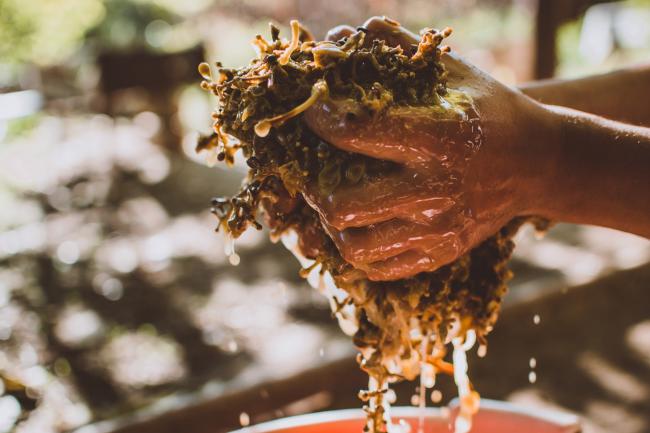Exploitation of by-products of grape-wine production chain

Optimizing the exploitation of raw materials produced in the vineyard, according to a circular scheme to enhance the noble components of the by-products and put the final waste back into play to produce energy, returning it to the vine in the form of nourishment. In particular:
- Increase profitability, competitiveness, diversification, thanks to the development of new products with market value (extracted from immature grapes, pomace and scum - quality wines from pomace and vinification scum, high quality grape seed oil)
- Realize prototypes and implement operational protocols for the exploitation of by-products and the reuse of waste
Innovative technologies and processing techniques will be introduced.
In particular, the transfer of innovation will be addressed for the exploitation of the following byproducts: Unripe grapes, Pomace, Lees, Grape seeds.
The introduction of innovations will be implemented through
- Visits in the field, in the cellar, in the company
- Prototype adaptation
- Testing tests
- Demonstration fields
- Meetings
According to a circular approach to the optimal introduction and recovery of resources, the final waste of the above processes will be reused to produce energy from biogas and, finally, the residue will be composted and used to restore organic substance to the soil.
The Tuscan wine supply chain is based on a vineyard heritage of 54,152 hectares in production and 3.5 million quintals of grapes harvested (source Regione Toscana 2017), the companies are about 26,120 (source Istat, 2010). Tuscany contributes to the national wine production with 2.6 million hectoliters, equal to 5% of the total (more than 48 million hectoliters) (Report UniCESV 2016). The 58 PDO and IGT attest to the choice to produce quality wines, also with the attention to the image (landscape and environmental) of the territory that drives an important regional agritourism movement: there are over 4,500 businesses in Tuscany compared to the total Italy of 22.661 (CREA 2017), many of which are enotourist.
At the same time, the wine sector is known for generating a high quantity of by-products and waste (pomace, lees, and other organic residues). In general, the pomace represents 20-30% of the weight of the grapes used, while it is estimated that about 5% of the total volume of wine produced constitutes the residue, which is more than 100,000 hectoliters per year.
The current destination of by-products and waste from the supply chain (distillation, energy production, soil improvers) exposes companies to economic losses deriving from the partial exploitation of the resources produced, generates management costs and can create problems from an environmental point of view. The question invests all vine-growing companies and its possible solution is part of a broader sustainable vision.
The project UVA PRETIOSA aims to find new grape-wine production by-products reuses technics
using a circular scheme in order to valorize their noble components and to reuse wastes to produce
energy in order to increase the economic and environmental sustainability of the process.
The preliminary results of analysis done on lees shown that these are interesting due to their potential
to produce energy (about 390 m3 of methane per ton of dry organic substance) and do not have any
bacteriostatic or bactericide effect on microorganisms, therefore they can be used to produce biogas.
Next steps will allow to investigate on logistical and economical aspects linked to production,
collection and transportation of the lees to the biogas production facility, checking the quantity of lees
compatible with the facility conditions of operation and the water content suitable for the lees
transportation using a tank.
Moreover, trials to produce oil from grape seeds have been performed. The machine can treat 300 kg
of pomace quickly. Then, the grape seeds drying have to be quickly performed until the seeds reach
10-12% humidity to allow the oil extraction. In the next months, we will work to reduce the time
needed for this operation.
| Titolo/Descrizione | Url | Tipologia |
|---|---|---|
|
sito web del progetto
|
Sito web
|
|
|
Video di presentazione del progetto
|
Materiali utili
|
|
|
Video del webinar Uso di uva immatura per vini senza solfiti e valorizzazione di vinaccioli
|
Materiali utili
|
|
|
Relazione finale del progetto UVA PRETIOSA
|
Materiali utili
|
|
|
Registrazioni del webinar tenutosi il Venerdì 8 aprile
|
Materiali utili
|
|
|
Manuale delle buone pratiche di marketing
|
Materiali utili
|
|
|
L’olio di vinaccioli e la filiera vitivinicola: soluzioni tecniche ed opportunità di mercato - Risultati del progetto
|
Materiali utili
|
|
|
Valorizzazione dei sottoprodotti della filiera viti-enologica: uso del biodigestato per migliorare l’efficienza del vigneto - Risultati del progetto
|
Materiali utili
|
|
|
Prove di utilizzo di un estratto di uva immatura in alternativa alla solforosa per la maturazione in legno di vino Sangiovese - Risultati del progetto
|
Materiali utili
|
|
|
Vini senza solfiti aggiunti addizionati di estratto di uva immatura: una valutazione della sostenibilità economica dell’innovazione del processo alla luce delle tendenze di mercato - Risultati del progetto
|
Materiali utili
|
